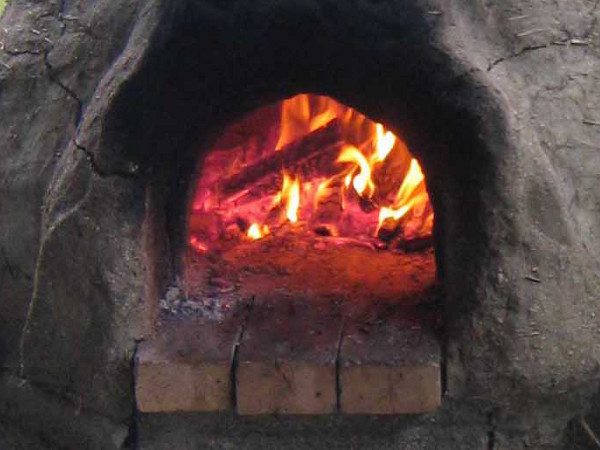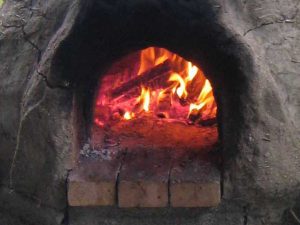“The earth under your feet — one of the best building materials on the planet; and the skills you need are just the ones you were born with.” – Kiko Denzer
Contents
What are earth ovens?
Earth (or clay or cob) ovens are traditional retained-heat ovens that have been used in many different cultures for millennia. Earth ovens use non-fossil fuels – sticks, wood, grasses or brash faggots (bundles of small-dimension twigs). The heat generated by burning the fuel is absorbed into the thermal mass of the oven, and the food is then cooked by radiation (heat radiated through the air), conduction (heat transferred directly from the body of the oven) and convection (the circulation of hot air), all of which comes from the heat of the fuel stored in the thermal mass of the clay. Gas or electric ovens don’t have the thermal mass, and cook mostly by convection.

Mixing the clay and sand, and practicing salsa dancing at the same time.
Normally in the UK, they are made from clayey earth mixed with sand, but they can also be made out of neat clay. The shape of a typical oven is like an upside-down clay pot with a door at the front that fits snugly – because the oven was sculpted around it. Clay ovens are found in indigenous cultures all over the world – and are used a lot for bread, but also for stews and joints of meat. Pizzas are particularly good from an earth oven.

Laying fire bricks for a large earth oven with a log for a base.
There are different types: they can be built with only one chamber, which functions as both the burn chamber and the cooking chamber; but they can also be built with two chambers – a firebox and a cooking chamber. They can be built with or without a chimney, and with or without an insulation layer – clay mixed with wood chip, straw or vermiculite; and they usually have a wooden door.
Earth ovens are built using cob building techniques, and in the same way that cob is useful for providing thermal mass to keep you warm inside buildings, an earth oven provides thermal mass to cook food.

‘Dragon’ earth oven fired up and ready to go.
What are the benefits of earth ovens?
- It’s a way of building an oven and cooking in it that has a low impact on nature.
- Clayey earth is a natural, abundant and free material, and is often a waste product from building sites after foundation trenches have been dug.
- It’s also biodegradable and usually local, so you don’t have to transport it.
- Earth ovens allow you to cook using a local renewable resource – usually wood.
- They make food taste better – its not just in the mind. Because they cook with 3 different heat sources, when cooking bread or pizza you get a firm bottom crust from contact with the oven floor, a caramelised top crust and a perfect even bake with no hot spots.
- They can be a focus for social gatherings and community groups, both at the building stage, and when it comes to cooking in them.
- They allow a lot of artistic expression – you can create animals, plaster them with beautiful patterns, and you can incorporate them into earth benches or existing buildings and different kinds of bases.
- They are very easy to build by people with no building experience.
- In a remote location with no mains utilities, an earth oven is your only option for baking – apart from a brick or metal oven, which isn’t so environmentally-friendly.

Covering a dome of damp sand (with wooden door attached) with wet newspaper; the oven will be built around this, and then the sand scraped out to form the chamber.
However, earth ovens can consume a lot of wood, which would be fine is there weren’t 7 billion of us, as it’s a renewable resource. There are people working on more efficient types of oven, using masonry stove technology, but with the principles of a rocket stove. The fuel needs to be somehow burnt hotter and faster, and it would be good to have a secondary burn chamber to combust all the gases and capture the heat from the flue. A traditional earth oven doesn’t do these things. But a traditional oven with a flue can be located inside your house, so that the wood can be used to heat your space as well.
The stages of building a cob oven, by our friends at the Roundhouse Company.
What can I do?
Building an earth oven can be a great community event, and so can cooking in it. It’s a good idea to invite some people round for both.
Building
First test the local soil – get the clay wet, roll it into a sausage and wind it around your finger. If it doesn’t crack, it’s probably neat clay, but if it cracks slightly, it could still be fine. A more detailed description of soil testing, including shaking soil samples in jars filled with water, can be found in Kiko Denzer’s book Build your own Earth Oven.

Building up an oven around a dome of sand.
Build a base and get it up to a comfortable height. The base can be bricks, a large log, or stones. The base can also store thermal mass. On top of the base goes a bed of sand, then a layer of fire bricks (which can be obtained second-hand from salvage yards), and then a dome of wet sand. This dome of sand is scraped out after the oven is built to form the chamber. It can also be done with a wicker basket that will burn out when the oven is used for the first time.
Mix the clayey earth and sand and a splash of water, and dance on it on a tarpaulin. Use this mix to construct the oven over the dome of sand like an upside-down pot. Put the door in and build round it. Then the insulation layer is added, and finally a fine, sieved layer for a plaster, that can contain designs of your choosing.

Adding a clay-straw mix insulation layer.
If building a one-chamber oven, there is a precise relationship between the size of chamber and the size of door. More details can be found in Kiko Denzer’s book, or you can attend a course for more information and practical experience.
NB: earth ovens don’t like rain, and so you will need some sort of basic roof, or it needs to be covered when not in use.

Plastering details can be added to the final, sieved layer.
Cooking
Cooking with an earth oven is a learned skill. There are no dials like a normal oven, and so you have to experiment and become experienced. The more you use it, the better you get.
The oven is best fired using quite small-dimension wood – nothing thicker than your wrist. Larger pieces of wood burn less efficiently, and not hot or fast enough. In a 2-chamber oven you can cook while the fire is going, but with a one-chamber oven, you build up the fire and when it’s burnt down a bit, push the embers to the outside and put the food in. Remember that it’s not the fire that cooks the food, it’s the stored heat.

Earth oven fired up.
Because of the retained heat, different sorts of food can be cooked in descending order of heat requirement – for example: pizza, bread, stew, porridge. So, get your friends round, get some refreshments in, and away you go!
Specialist(s)
Thanks to Adrian Leaman of Wholewoods for information.
The specialist(s) below will respond to queries on this topic. Please comment in the box at the bottom of the page.
 Adrian Leaman of Wholewoods helped Ben Law to build his Woodland House in 2002, and since then has been roundwood timber framing, particularly reciprocal roof roundhouse building, and sharing woodland and woodcraft skills with people from all walks of life. He is a Forest School Leader and works with adults and teenagers on educational projects.
Adrian Leaman of Wholewoods helped Ben Law to build his Woodland House in 2002, and since then has been roundwood timber framing, particularly reciprocal roof roundhouse building, and sharing woodland and woodcraft skills with people from all walks of life. He is a Forest School Leader and works with adults and teenagers on educational projects.



1 Comment
The clay pizza oven has given me a new interest in life. I have just finished building one but I think I have made a mistake. The chimney is just inside the outer arch but the door is on the outside of the chimney instead of the inside so I can’t keep the heat completely in. It makes great pizzas but I don’t know how I will get on with bread but I suppose I can put a plug in the flue when I remove the fire when baking bread. If that doesn’t work I will make a clat surround inside the chimney for an inner door. Regards, John